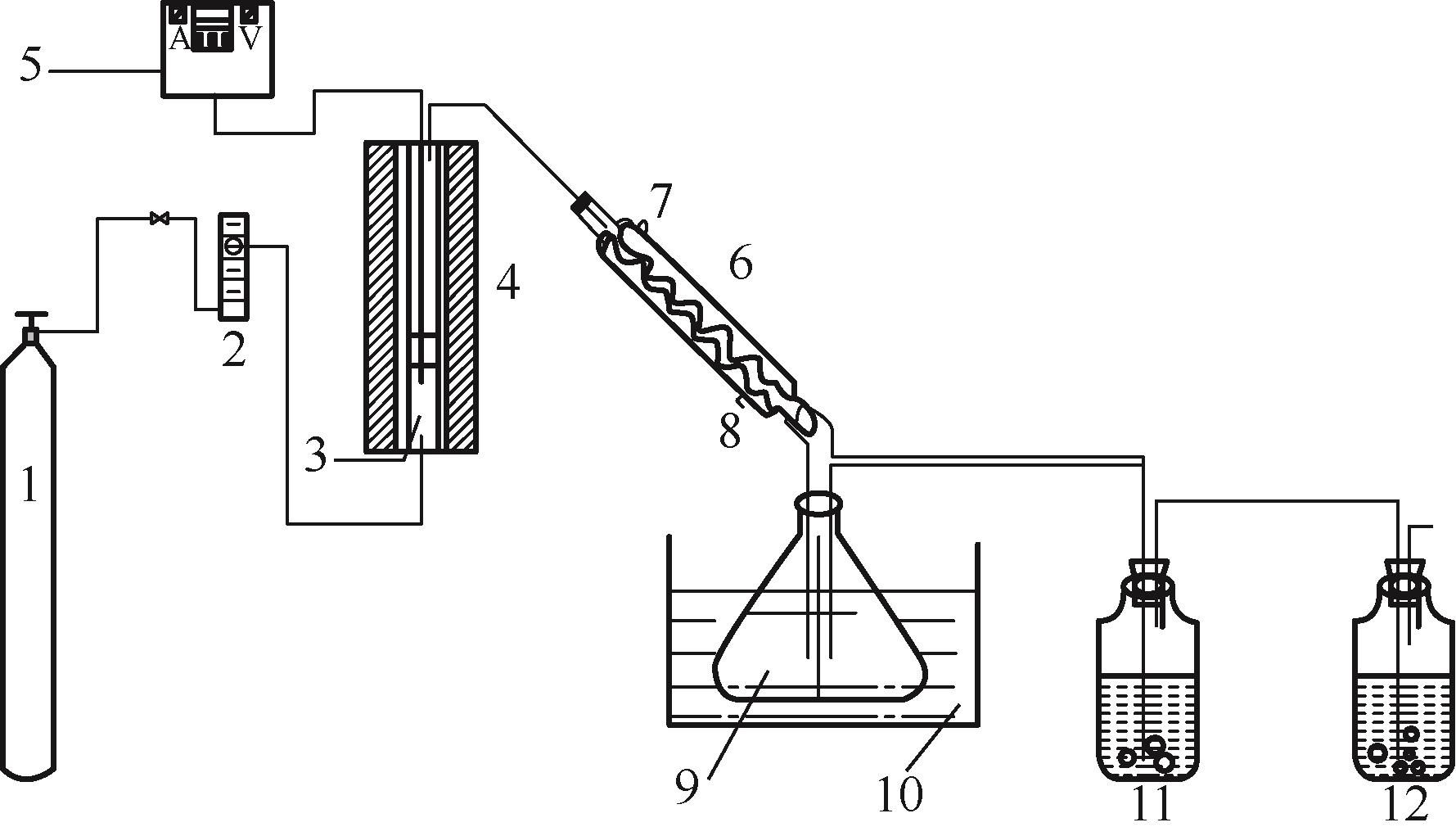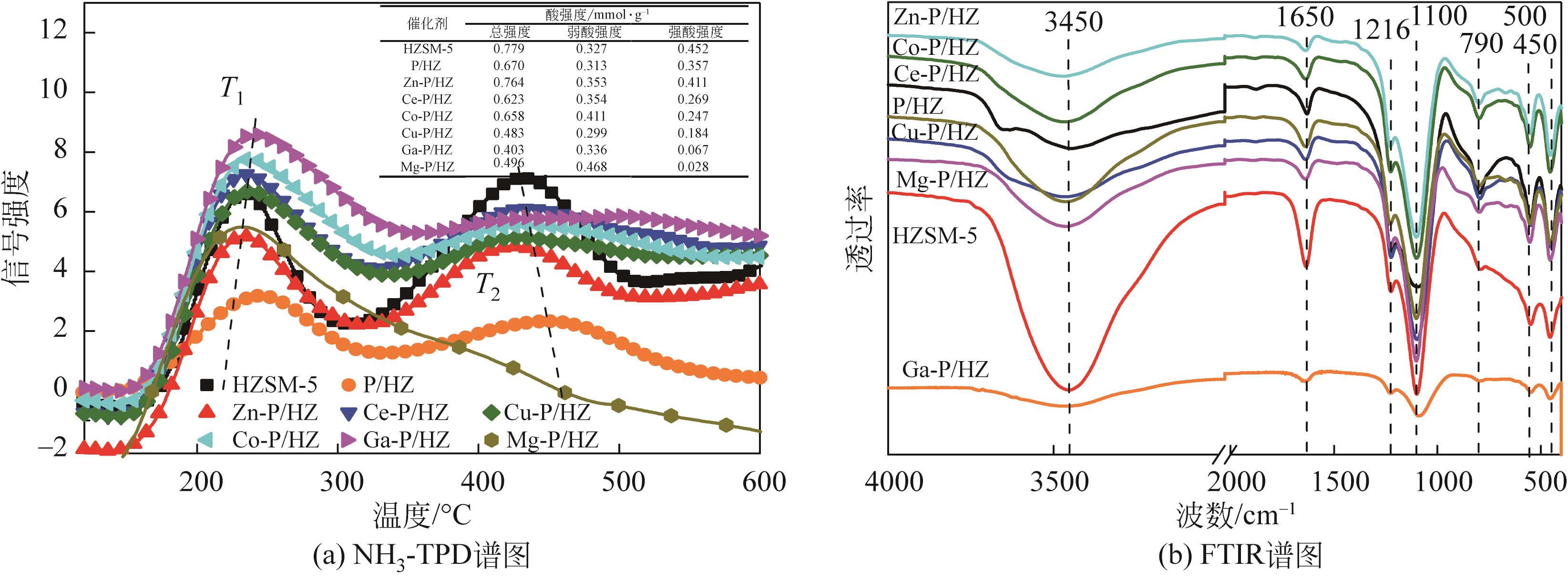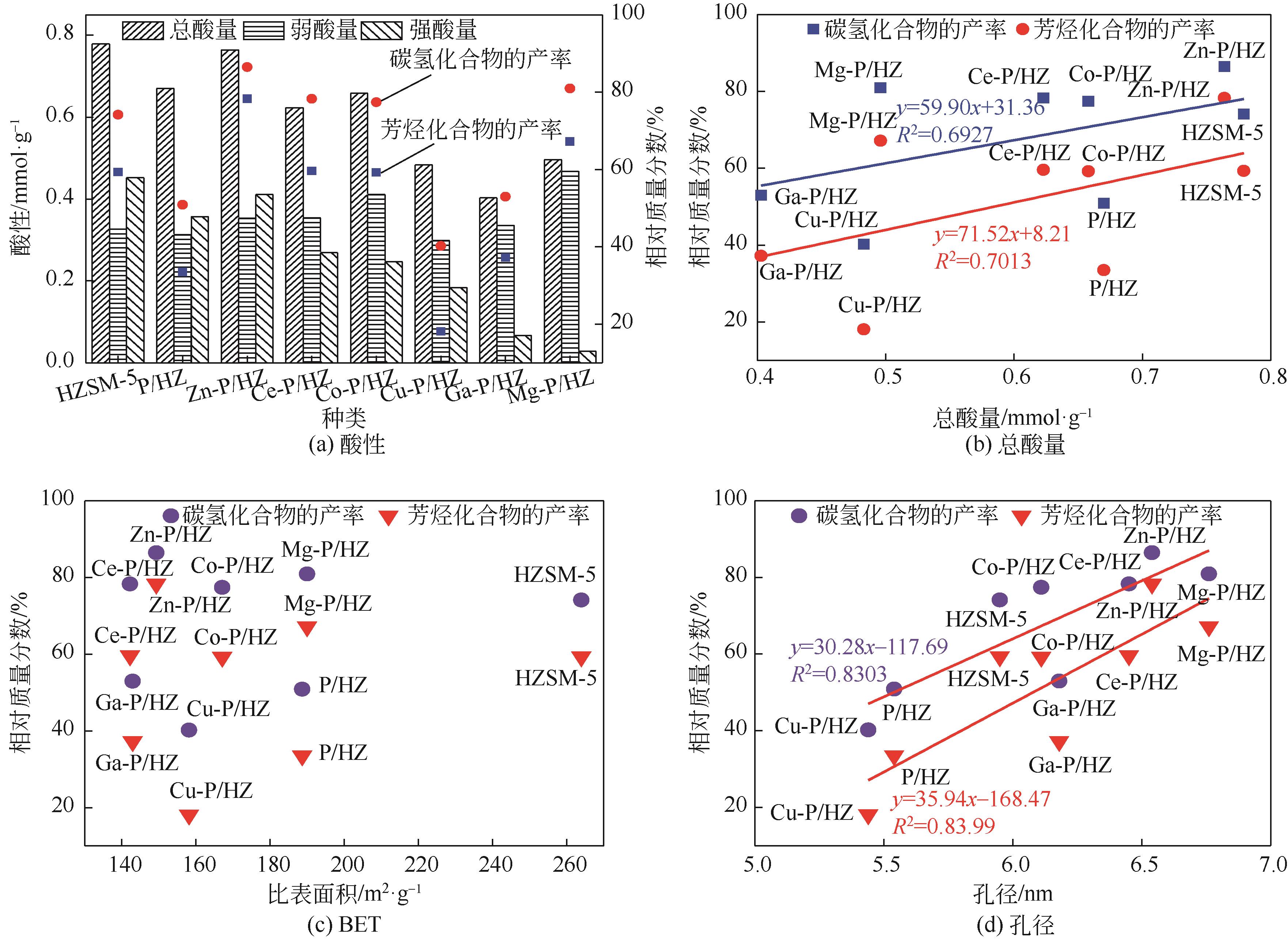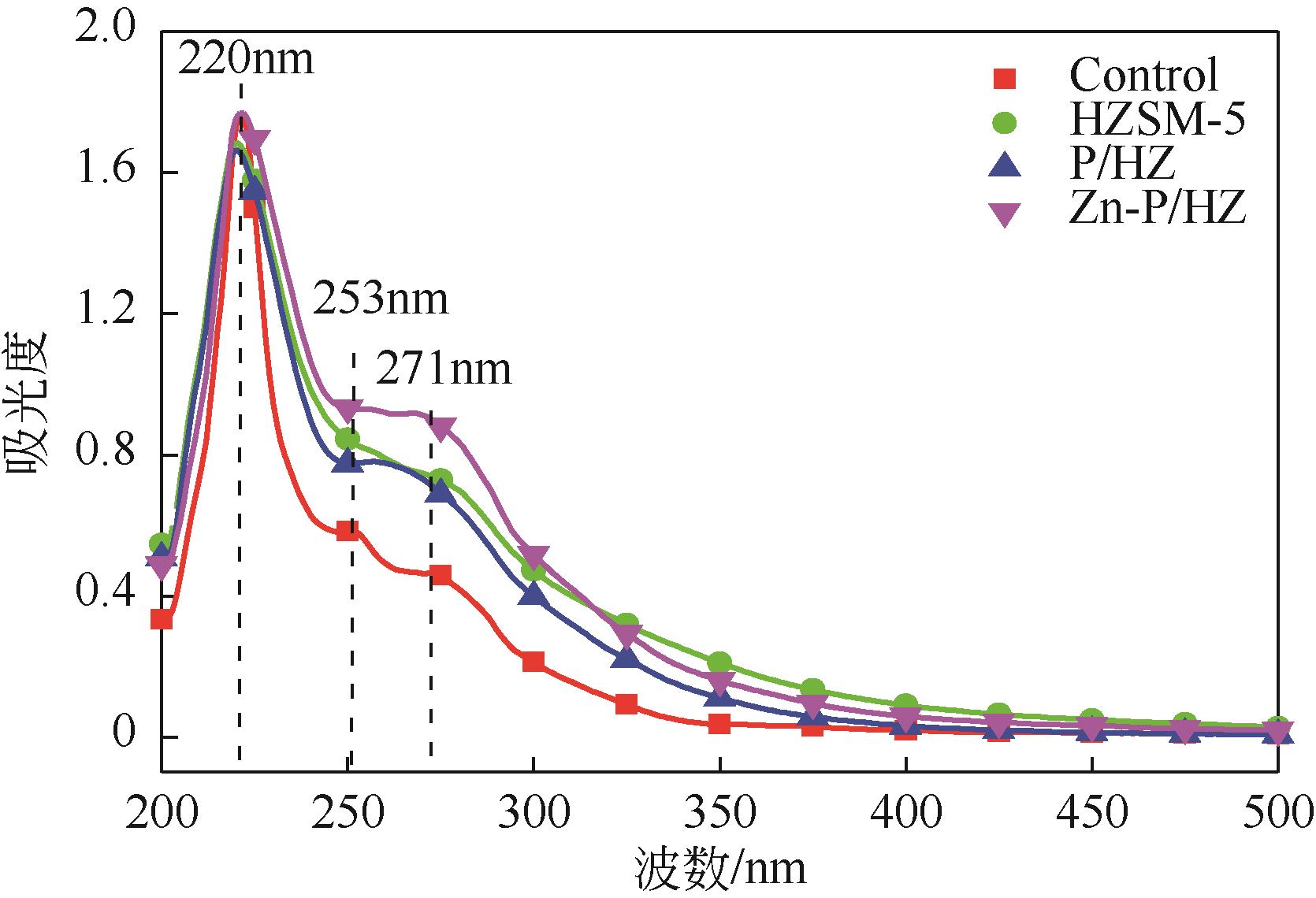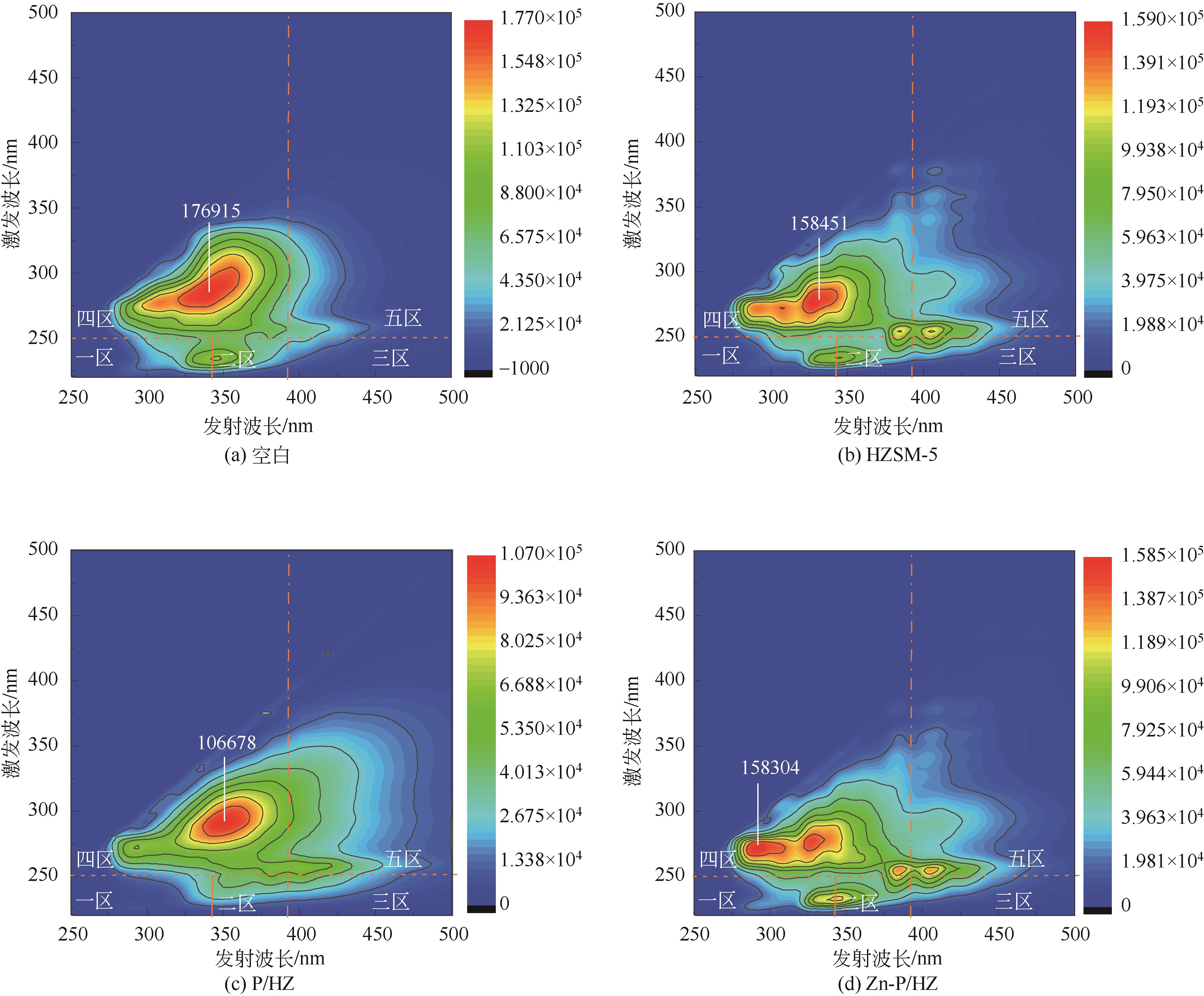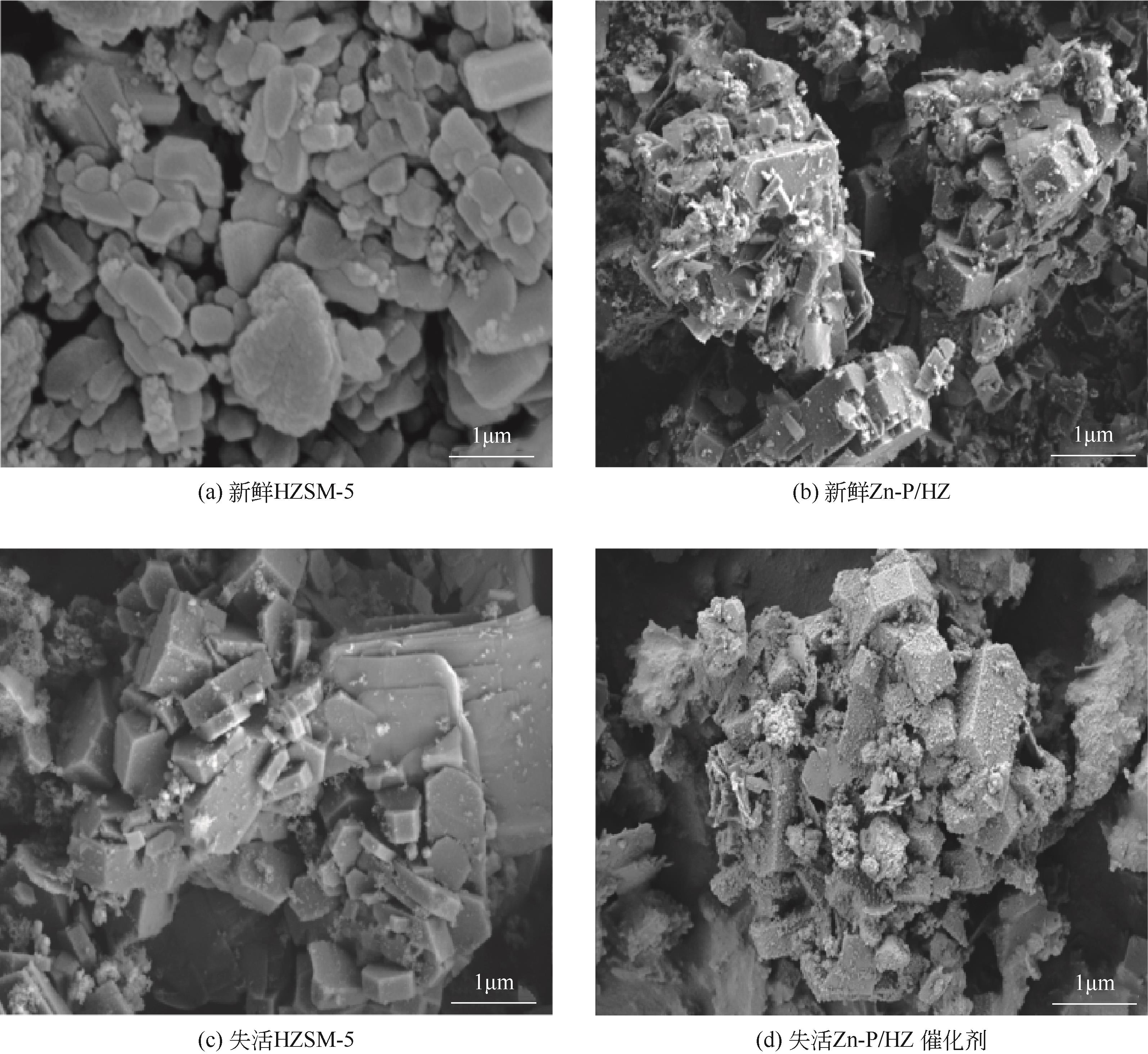化工进展 ›› 2023, Vol. 42 ›› Issue (3): 1353-1364.DOI: 10.16085/j.issn.1000-6613.2022-0865
金属氧化物活化P/HZSM-5催化生物质热解气重整制备富烃生物油
郑云武1,2( ), 裴涛1,2, 李冬华1,2, 王继大1,2, 李继容1,2, 郑志锋1,3(
), 裴涛1,2, 李冬华1,2, 王继大1,2, 李继容1,2, 郑志锋1,3( )
)
- 1.西南林业大学林业生物质资源高效利用技术国家地方联合工程研究中心,云南 昆明 650224
2.西南林业大学材料科学与工程学院,云南 昆明 650224
3.厦门市现代农业生物质高值化技术重点实验室(厦门大学),福建省生物质高值化技术工程研究中心(厦门大学),厦门大学能源学院,福建 厦门 361102
-
收稿日期:2022-05-10修回日期:2022-07-07出版日期:2023-03-15发布日期:2023-04-10 -
通讯作者:郑志锋 -
作者简介:郑云武(1983—),男,博士,副教授,硕士生导师,研究方向为生物质热化学转化。E-mail:zyw85114@163.com。 -
基金资助:国家重点研发计划(2019YFD1002404);国家自然科学基金(31670599);云南省高等学校大学生创新创业项目
Production of hydrocarbon-rich bio-oil by catalytic biomass pyrolysis over metal oxide improved P/HZSM-5 catalyst
ZHENG Yunwu1,2( ), PEI Tao1,2, LI Donghua1,2, WANG Jida1,2, LI Jirong1,2, ZHENG Zhifeng1,3(
), PEI Tao1,2, LI Donghua1,2, WANG Jida1,2, LI Jirong1,2, ZHENG Zhifeng1,3( )
)
- 1.National Joint Engineering Research Center for Highly-Efficient Utilization Technology of Forest Biomass Resources, Southwest Forestry University, Kunming 650224, Yunnan, China
2.College of Materials Science and Engineering, Southwest Forestry University, Kunming 650224, Yunnan, China
3.Xiamen Key Laboratory for High-valued Conversion Technology of Agricultural Biomass (Xiamen University), Fujian Provincial Engineering and Research Center of Clean and High-valued Technologies for Biomass, College of Energy, Xiamen University, Xiamen 361102, Fujian, China
-
Received:2022-05-10Revised:2022-07-07Online:2023-03-15Published:2023-04-10 -
Contact:ZHENG Zhifeng
摘要:
为了探讨催化剂的酸性和孔道结构与热解产物之间的构-效关系,采用金属改性的M-P/HZSM-5(M=Zn、Ce、Co、Cu、Ga和Mg)为催化剂,催化生物质热解气相重整制备富烃生物油,探究金属的种类对产品的产率以及选择性的影响,采用XRD、BET、NH3-TPD、FTIR对催化剂进行表征,采用GC/MS、UV-荧光光谱和元素分析仪对重整生物油的产物组成、脱氧特性以及共轭结构进行分析,并用TGA、拉曼光谱和SEM对失活催化剂进行评价,探究其结构-性能关系以及催化失活机制。结果表明:金属的添加并未改变催化剂的骨架结构,但形成了新的金属位点,调整了催化剂酸性分布,使比表面积以及孔容下降,平均孔径增加。金属位和酸性位的协同作用明显地促进了生物油的脱氧和单环芳烃的转化,脱氧顺序为Zn>Mg>Co>Ce>HZSM-5>Ga>P>Cu,且芳烃产率与总酸含量呈正相关,较高的酸度和平均孔径以及适宜的比表面积有利于芳烃的生成。然而,较低的酸度和较小的孔径促进了烯烃化合物的转化。当采用Zn-P/HZ为催化剂时,碳氢和芳烃产率最高,为86.46%和78.29%,共轭体系最大。Zn促进了苯、甲苯和烷基苯的形成,Mg促进了二甲苯的转化,而Cu和Ga促进了轻质烯烃的形成,金属的添加明显地降低了石墨化程度,提高了抗结焦性能。
中图分类号:
引用本文
郑云武, 裴涛, 李冬华, 王继大, 李继容, 郑志锋. 金属氧化物活化P/HZSM-5催化生物质热解气重整制备富烃生物油[J]. 化工进展, 2023, 42(3): 1353-1364.
ZHENG Yunwu, PEI Tao, LI Donghua, WANG Jida, LI Jirong, ZHENG Zhifeng. Production of hydrocarbon-rich bio-oil by catalytic biomass pyrolysis over metal oxide improved P/HZSM-5 catalyst[J]. Chemical Industry and Engineering Progress, 2023, 42(3): 1353-1364.
| 催化剂试样 | 比表面积SBET /m2·g-1 | 微孔表面积Smicro /m2·g-1 | 外表面积Sext /m2·g-1 | 总孔容Vtotal /mL·g-1 | 介孔孔容Vmeso /mL·g-1 | 微孔孔容Vmicro /mL·g-1 | 平均孔径Dpore size /nm-1 |
|---|---|---|---|---|---|---|---|
| HZSM-5 | 263.99 | 116.92 | 147.08 | 0.2522 | 0.1914 | 0.06083 | 5.95 |
| P/HZ | 188.67 | 116.01 | 70.22 | 0.1774 | 0.1171 | 0.06034 | 5.54 |
| Zn-P/HZ | 149.27 | 107.40 | 41.88 | 0.1158 | 0.05999 | 0.05581 | 6.54 |
| Ce-P/HZ | 142.23 | 104.81 | 37.43 | 0.1053 | 0.05088 | 0.05442 | 6.45 |
| Co-P/HZ | 167.06 | 140.96 | 26.09 | 0.1119 | 0.03886 | 0.07304 | 6.11 |
| Cu-P/HZ | 158.15 | 119.28 | 38.86 | 0.1087 | 0.04674 | 0.06196 | 5.44 |
| Ga-P/HZ | 142.91 | 100.77 | 42.14 | 0.1110 | 0.05862 | 0.05238 | 5.18 |
| Mg-P/HZ | 169.99 | 102.81 | 67.17 | 0.1283 | 0.06955 | 0.05875 | 6.76 |
表1 金属改性P/HZ催化剂的孔道结构
| 催化剂试样 | 比表面积SBET /m2·g-1 | 微孔表面积Smicro /m2·g-1 | 外表面积Sext /m2·g-1 | 总孔容Vtotal /mL·g-1 | 介孔孔容Vmeso /mL·g-1 | 微孔孔容Vmicro /mL·g-1 | 平均孔径Dpore size /nm-1 |
|---|---|---|---|---|---|---|---|
| HZSM-5 | 263.99 | 116.92 | 147.08 | 0.2522 | 0.1914 | 0.06083 | 5.95 |
| P/HZ | 188.67 | 116.01 | 70.22 | 0.1774 | 0.1171 | 0.06034 | 5.54 |
| Zn-P/HZ | 149.27 | 107.40 | 41.88 | 0.1158 | 0.05999 | 0.05581 | 6.54 |
| Ce-P/HZ | 142.23 | 104.81 | 37.43 | 0.1053 | 0.05088 | 0.05442 | 6.45 |
| Co-P/HZ | 167.06 | 140.96 | 26.09 | 0.1119 | 0.03886 | 0.07304 | 6.11 |
| Cu-P/HZ | 158.15 | 119.28 | 38.86 | 0.1087 | 0.04674 | 0.06196 | 5.44 |
| Ga-P/HZ | 142.91 | 100.77 | 42.14 | 0.1110 | 0.05862 | 0.05238 | 5.18 |
| Mg-P/HZ | 169.99 | 102.81 | 67.17 | 0.1283 | 0.06955 | 0.05875 | 6.76 |
| 序号 | 催化剂的种类 | 热解温度/℃ | 产物组成 | 产品产率/% | 参考文献 |
|---|---|---|---|---|---|
| 1 | HZSM-5/赤泥 | 475 | 芳烃 | 53.44 | [ |
| 2 | HZSM-5/MCM-41 | 600 | 芳烃 | 41.44 | [ |
| 3 | HZSM-5 | 600 | 芳烃 | 34.41 | [ |
| 4 | CaO@HZSM-5 | 550 | 芳烃 | 31.34 | [ |
| 5 | TiO2@HZSM-5 | 550 | BTX | 23.58 | [ |
| 6 | HZSM-5 | 550 | BTX | 16.96 | [ |
| 7 | CeO2-ZrO2-Al2O3 | 600 | 芳烃 | 20.23 | [ |
| 8 | ZnO@HZSM-5 | 500 | 芳烃 | 72.28 | 本研究 |
表2 不同工艺条件下竹材热解制备芳烃生物油
| 序号 | 催化剂的种类 | 热解温度/℃ | 产物组成 | 产品产率/% | 参考文献 |
|---|---|---|---|---|---|
| 1 | HZSM-5/赤泥 | 475 | 芳烃 | 53.44 | [ |
| 2 | HZSM-5/MCM-41 | 600 | 芳烃 | 41.44 | [ |
| 3 | HZSM-5 | 600 | 芳烃 | 34.41 | [ |
| 4 | CaO@HZSM-5 | 550 | 芳烃 | 31.34 | [ |
| 5 | TiO2@HZSM-5 | 550 | BTX | 23.58 | [ |
| 6 | HZSM-5 | 550 | BTX | 16.96 | [ |
| 7 | CeO2-ZrO2-Al2O3 | 600 | 芳烃 | 20.23 | [ |
| 8 | ZnO@HZSM-5 | 500 | 芳烃 | 72.28 | 本研究 |
| 试样 | C/% | H/% | O/% | N/% | S/% | H/C | O/C | 热值/MJ·kg-1 | 脱氧效率/% | 有效氢碳比 | 重整常数/% |
|---|---|---|---|---|---|---|---|---|---|---|---|
| 热解油 | 52.14 | 6.48 | 40.71 | 0.55 | 0.12 | 0.124 | 0.781 | 21.63 | 0 | 0.2913 | 0 |
| HZSM-5 | 66.73 | 7.83 | 25.05 | 0.28 | 0.11 | 0.117 | 0.375 | 29.94 | 73.23 | 0.8329 | 2.3587 |
| P/HZ | 64.99 | 7.64 | 26.91 | 0.33 | 0.13 | 0.118 | 0.414 | 28.92 | 49.14 | 0.7750 | 0.7752 |
| Zn-P/HZ | 69.88 | 8.01 | 21.63 | 0.38 | 0.10 | 0.115 | 0.310 | 31.60 | 85.98 | 0.8961 | 5.6908 |
| Ce-P/HZ | 69.26 | 7.82 | 22.56 | 0.27 | 0.09 | 0.113 | 0.326 | 31.07 | 77.54 | 0.8553 | 3.0561 |
| Co-P/HZ | 67.91 | 6.73 | 24.76 | 0.44 | 0.16 | 0.099 | 0.365 | 29.09 | 76.60 | 0.6239 | 2.1147 |
| Cu-P/HZ | 60.02 | 6.96 | 32.63 | 0.28 | 0.11 | 0.116 | 0.544 | 25.79 | 38.12 | 0.5627 | 0.3588 |
| Ga-P/HZ | 65.13 | 6.58 | 27.74 | 0.47 | 0.08 | 0.101 | 0.426 | 27.62 | 51.33 | 0.5540 | 0.6047 |
| Mg-P/HZ | 68.62 | 7.75 | 23.33 | 0.22 | 0.08 | 0.113 | 0.340 | 30.68 | 80.26 | 0.8362 | 3.5192 |
表3 重整生物油的元素分析
| 试样 | C/% | H/% | O/% | N/% | S/% | H/C | O/C | 热值/MJ·kg-1 | 脱氧效率/% | 有效氢碳比 | 重整常数/% |
|---|---|---|---|---|---|---|---|---|---|---|---|
| 热解油 | 52.14 | 6.48 | 40.71 | 0.55 | 0.12 | 0.124 | 0.781 | 21.63 | 0 | 0.2913 | 0 |
| HZSM-5 | 66.73 | 7.83 | 25.05 | 0.28 | 0.11 | 0.117 | 0.375 | 29.94 | 73.23 | 0.8329 | 2.3587 |
| P/HZ | 64.99 | 7.64 | 26.91 | 0.33 | 0.13 | 0.118 | 0.414 | 28.92 | 49.14 | 0.7750 | 0.7752 |
| Zn-P/HZ | 69.88 | 8.01 | 21.63 | 0.38 | 0.10 | 0.115 | 0.310 | 31.60 | 85.98 | 0.8961 | 5.6908 |
| Ce-P/HZ | 69.26 | 7.82 | 22.56 | 0.27 | 0.09 | 0.113 | 0.326 | 31.07 | 77.54 | 0.8553 | 3.0561 |
| Co-P/HZ | 67.91 | 6.73 | 24.76 | 0.44 | 0.16 | 0.099 | 0.365 | 29.09 | 76.60 | 0.6239 | 2.1147 |
| Cu-P/HZ | 60.02 | 6.96 | 32.63 | 0.28 | 0.11 | 0.116 | 0.544 | 25.79 | 38.12 | 0.5627 | 0.3588 |
| Ga-P/HZ | 65.13 | 6.58 | 27.74 | 0.47 | 0.08 | 0.101 | 0.426 | 27.62 | 51.33 | 0.5540 | 0.6047 |
| Mg-P/HZ | 68.62 | 7.75 | 23.33 | 0.22 | 0.08 | 0.113 | 0.340 | 30.68 | 80.26 | 0.8362 | 3.5192 |
| 1 | HOANG AT, ONG H C, FATTAH I R, et al. Progress on the lignocellulosic biomass pyrolysis for biofuel production toward environmental sustainability[J]. Fuel Processing Technology, 2021, 223: 106997. |
| 2 | TAWALBEH M, AL-OTHMAN A, SALAMAH T, et al. A critical review on metal-based catalysts used in the pyrolysis of lignocellulosic biomass materials[J]. Journal of Environmental Management, 2021, 299: 113597. |
| 3 | JIN Y, LIU J, YANG H, et al. Improving enzymatic saccharification and ethanol production of bamboo residues with sulfomethylation-aided phosphoric acid pretreatment[J]. Industrial Crops and Products, 2021, 170: 113733. |
| 4 | LI N, MENG F, YANG H, et al. Enhancing enzymatic digestibility of bamboo residues using a three-constituent deep eutectic solvent pretreatment[J]. Bioresource Technology, 2022, 346:126639. |
| 5 | DADA T K, SHEEHAN M, MURUGAVELH S, et al. A review on catalytic pyrolysis for high-quality bio-oil production from biomass[J]. Biomass Conversion and Biorefinery, 2021: 1-20. |
| 6 | BALASUNDRAM V, IBRAHIM N, KASMANI R M, et al. Catalytic upgrading of biomass-derived pyrolysis vapour over metal-modified HZSM-5 into BTX: A comprehensive review[J]. Biomass Conversion and Biorefinery, 2022, 12(5): 1911-1938. |
| 7 | ZHENG Y W, WANG J D, WANG D C, et al. Advanced catalytic upgrading of biomass pyrolysis vapor to bio-aromatics hydrocarbon: A review[J]. Applications in Energy and Combustion Science, 2022,10: 100061. |
| 8 | LIU R H, RAHMAN M M, SARKER M, et al. A review on the catalytic pyrolysis of biomass for the bio-oil production with ZSM-5: Focus on structure[J]. Fuel Processing Technology, 2020, 199: 106301. |
| 9 | SERAPIGLIA M J, MULLEN C A, SMART L B, et al. Variability in pyrolysis product yield from novel shrub willow genotypes[J]. Biomass and Bioenergy, 2015, 72: 74-84. |
| 10 | TEIMOURISENDESI S M, TOWFIGHI J, KEYVANLOO K. The effect of Fe, P and Si/Al molar ratio on stability of HZSM-5 catalyst in naphtha thermal-catalytic cracking to light olefins[J]. Catalysis Communications, 2012, 27: 114-118. |
| 11 | BUTTER S A, KAEDING W W. Phosphorus-containing zeolite catalyst: US3972832[P]. 1976-08-03. |
| 12 | LIANG J, SHAN G C, SUN Y F. Catalytic fast pyrolysis of lignocellulosic biomass: Critical role of zeolite catalysts[J]. Renewable and Sustainable Energy Reviews, 2021, 139: 110707. |
| 13 | JIN T, WANG H T, PENG J B, et al. Catalytic pyrolysis of lignin with metal-modified HZSM-5 as catalysts for monocyclic aromatic hydrocarbons production[J]. Fuel Processing Technology, 2022, 230: 107201. |
| 14 | ZHENG Y W, WANG F, YANG X Q, et al. Study on aromatics production via the catalytic pyrolysis vapor upgrading of biomass using metal-loaded modified H-ZSM-5[J]. Journal of Analytical and Applied Pyrolysis, 2017, 126: 169-179. |
| 15 | LI X H, CHEN L, FAN Y S, et al. Study on preparation of refined oil by upgrading of pyrolytic vapors using Zn-P/HZSM-5 zeolite[J]. Journal of Fuel Chemistry and Technology, 2015, 43(5): 567-574. |
| 16 | FAN Y S, HOU G X, LU D S, et al. A novel production of aromatic hydrocarbons via dielectric barrier discharge assisted one-stage pyrolysis-catalysis of biomass: Insights into modified HZSM-5 selectivity and stability[J]. Journal of Analytical and Applied Pyrolysis, 2022, 161: 105417. |
| 17 | KIM J W, PARK S H, JUNG J, et al. Catalytic pyrolysis of mandarin residue from the mandarin juice processing industry[J]. Bioresource Technology, 2013, 136: 431-436. |
| 18 | ZHANG L D, GAO J H, HU J X, et al. Lanthanum oxides-improved catalytic performance of ZSM-5 in toluene alkylation with methanol[J]. Catalysis Letters, 2009, 130(3/4): 355-361. |
| 19 | LIU C J, WANG H M, KARIM A M, et al. Catalytic fast pyrolysis of lignocellulosic biomass[J]. Chemical Society Reviews, 2014, 43(22) :7594-7623. |
| 20 | OSEKE G G, ATTA A Y, MUKHTAR B, et al. Highly selective and stable Zn-Fe/ZSM-5 catalyst for aromatization of propane[J]. Applied Petrochemical Research, 2020, 10(2): 55-65. |
| 21 | 葛笑, 苟进胜. 金属改性HZSM-5催化快速热解木聚糖制备芳烃化合物[J]. 包装工程, 2021, 42(21): 105-112. |
| GE Xiao, GOU Jinsheng. Catalytic fast pyrolysis of xylan to aromatic compounds by metal modified HZSM-5[J]. Packaging Engineering, 2021, 42(21): 105-112. | |
| 22 | HUANG M, MA Z Q, ZHOU B L, et al. Enhancement of the production of bio-aromatics from renewable lignin by combined approach of torrefaction deoxygenation pretreatment and shape selective catalytic fast pyrolysis using metal modified zeolites[J]. Bioresource Technology, 2020, 30: 122754. |
| 23 | NEUMANN G T, HICKS J C. Novel hierarchical cerium-incorporated MFI zeolite catalysts for the catalytic fast pyrolysis of lignocellulosic biomass[J]. ACS Catalysis, 2012, 2(4): 642-646. |
| 24 | 黄明, 朱亮, 马中青, 等. 金属改性分子筛催化热解木质素制取轻质芳烃[J]. 燃料化学学报, 2021, 49(3): 292-302. |
| HUANG Ming, ZHU Liang, MA Zhongqing, et al. Production of light aromatics from the fast pyrolysis of lignin catalyzed by metal modified H-ZSM-5 zeolites[J]. Journal of Fuel Chemistry and Technology, 2021, 49(3): 292-302. | |
| 25 | VESES A, PUÉRTOLAS B, LÓPEZ J M, et al. Promoting deoxygenation of bio-oil by metal-loaded hierarchical ZSM-5 zeolites[J]. ACS Sustainable Chemistry & Engineering, 2016, 4(3): 1653-1660. |
| 26 | CHENG S Y, WEI L, ZHAO X H, et al. Conversion of prairie cordgrass to hydrocarbon biofuel over Co-Mo/HZSM-5 using a two-stage reactor system[J]. Energy Technology, 2016, 4(6): 706-713. |
| 27 | FATHI S, SOHRABI M, FALAMAKI C. Improvement of HZSM-5 performance by alkaline treatments: Comparative catalytic study in the MTG reactions[J]. Fuel, 2014, 116: 529-537. |
| 28 | LIU J N, XIANG M, WU D F. Enhanced phenol hydrodeoxygenation over a Ni catalyst supported on a mixed mesoporous ZSM-5 zeolite and Al2O3 [J]. Catalysis Letters, 2017, 147(10): 2498-2507. |
| 29 | ZHENG Y W, WANG J D, LI D H, et al. Activity and selectivity of Ni-Cu bimetallic zeolites catalysts on biomass conversion for bio-aromatic and bio-phenols[J]. Journal of the Energy Institute, 2021, 97: 58-72. |
| 30 | LIU C C, USLAMIN E A, KHRAMENKOVA E, et al. High stability of methanol to aromatic conversion over bimetallic Ca, Ga-modified ZSM-5[J]. ACS Catalysis, 2022, 12(5): 3189-3200. |
| 31 | DING K, ZHONG Z P, WANG J, et al. Improving hydrocarbon yield from catalytic fast co-pyrolysis of hemicellulose and plastic in the dual-catalyst bed of CaO and HZSM-5[J]. Bioresource Technology, 2018, 261: 86-92. |
| 32 | YANG M F, SHAO J G, YANG H P, et al. Enhancing the production of light olefins and aromatics from catalytic fast pyrolysis of cellulose in a dual-catalyst fixed bed reactor[J]. Bioresource Technology, 2019, 273: 77-85. |
| 33 | KARNJANAKOM S, BAYU A, HAO X G, et al. Selectively catalytic upgrading of bio-oil to aromatic hydrocarbons over Zn, Ce or Ni-doped mesoporous rod-like alumina catalysts[J]. Journal of Molecular Catalysis A: Chemical, 2016, 421: 235-244. |
| 34 | LY H V, PARK J W, KIM S S, et al. Catalytic pyrolysis of bamboo in a bubbling fluidized-bed reactor with two different catalysts: HZSM-5 and red mud for upgrading bio-oil[J]. Renewable Energy, 2020, 149: 1434-1445. |
| 35 | LI Z Y, ZHONG Z P, ZHANG B, et al. Catalytic fast pyrolysis of bamboo over micro-mesoporous composite molecular sieves[J]. Energy Technology, 2018, 6(4): 728-736. |
| 36 | WANG J, ZHONG Z P, DING K, et al. Catalytic fast pyrolysis of bamboo sawdust via a two-step bench scale bubbling fluidized bed/fixed bed reactor: Study on synergistic effect of alkali metal oxides and HZSM-5[J]. Energy Conversion and Management, 2018,176: 287-298. |
| 37 | DU H R, ZHONG Z P, ZHANG B, et al. Ex-situ catalytic upgrading of vapors from microwave-assisted pyrolysis of bamboo with chemical liquid deposition modified HZSM-5 to enhance aromatics production[J]. Journal of Analytical and Applied Pyrolysis, 2020,149: 104857. |
| 38 | XUE Z Y, ZHONG Z P, ZHANG B, et al. Performance of catalytic fast pyrolysis using a γ-Al2O3 catalyst with compound modification of ZrO2 and CeO2 [J]. Catalysts, 2019, 9(10): 849. |
| 39 | QUAN C, GAO N B, SONG Q B. Pyrolysis of biomass components in a TGA and a fixed-bed reactor: Thermochemical behaviors, kinetics, and product characterization[J]. Journal of Analytical and Applied Pyrolysis, 2016, 121: 84-92. |
| 40 | ZHAO C, HE J Y, LEMONIDOU A A, et al. Aqueous-phase hydrodeoxygenation of bio-derived phenols to cycloalkanes[J]. Journal of Catalysis, 2011, 280(1): 8-16. |
| 41 | JAE J, TOMPSETT G A, FOSTER A J, et al. Investigation into the shape selectivity of zeolite catalysts for biomass conversion[J]. Journal of Catalysis, 2011, 279(2): 257-268. |
| 42 | CHEN W, WESTERHOFF P, LEENHEER J A, et al. Fluorescence excitation-emission matrix regional integration to quantify spectra for dissolved organic matter[J]. Environmental Science & Technology, 2003, 37(24): 5701-5710. |
| 43 | LI C, SUN Y F, YI Z J, et al. Co-pyrolysis of coke bottle wastes with cellulose, lignin and sawdust: Impacts of the mixed feedstock on char properties[J]. Renewable Energy, 2022, 181: 1126-1139. |
| [1] | 王帅晴, 杨思文, 李娜, 孙占英, 安浩然. 元素掺杂生物质炭材料在电化学储能中的研究进展[J]. 化工进展, 2023, 42(8): 4296-4306. |
| [2] | 吴亚, 赵丹, 方荣苗, 李婧瑶, 常娜娜, 杜春保, 王文珍, 史俊. 用于复杂原油乳液的高效破乳剂开发及应用研究进展[J]. 化工进展, 2023, 42(8): 4398-4413. |
| [3] | 郑梦启, 王成业, 汪炎, 王伟, 袁守军, 胡真虎, 何春华, 王杰, 梅红. 菌藻共生技术在工业废水零排放中的应用与展望[J]. 化工进展, 2023, 42(8): 4424-4431. |
| [4] | 关红玲, 杨辉, 井红权, 刘玉琼, 谷守玉, 王好斌, 侯翠红. 木质素基控释材料及其在药物输送和肥料控释中的应用[J]. 化工进展, 2023, 42(7): 3695-3707. |
| [5] | 于丁一, 李圆圆, 王晨钰, 纪永升. pH响应性木质素水凝胶的制备及药物控释[J]. 化工进展, 2023, 42(6): 3138-3146. |
| [6] | 吴锋振, 刘志炜, 谢文杰, 游雅婷, 赖柔琼, 陈燕丹, 林冠烽, 卢贝丽. 生物质基铁/氮共掺杂多孔炭的制备及其活化过一硫酸盐催化降解罗丹明B[J]. 化工进展, 2023, 42(6): 3292-3301. |
| [7] | 王雪, 徐期勇, 张超. 木质纤维素类生物质水热炭化机理及水热炭应用进展[J]. 化工进展, 2023, 42(5): 2536-2545. |
| [8] | 王志伟, 郭帅华, 吴梦鸽, 陈颜, 赵俊廷, 李辉, 雷廷宙. 生物质与塑料催化共热解技术研究进展[J]. 化工进展, 2023, 42(5): 2655-2665. |
| [9] | 刘静, 林琳, 张健, 赵峰. 生物质基炭材料孔径调控及电化学性能研究进展[J]. 化工进展, 2023, 42(4): 1907-1916. |
| [10] | 万茂华, 张小红, 安兴业, 龙垠荧, 刘利琴, 管敏, 程正柏, 曹海兵, 刘洪斌. MXene在生物质基储能纳米材料领域中的应用研究进展[J]. 化工进展, 2023, 42(4): 1944-1960. |
| [11] | 杨自强, 李风海, 郭卫杰, 马名杰, 赵薇. 市政污泥热处理过程中磷迁移转化的研究进展[J]. 化工进展, 2023, 42(4): 2081-2090. |
| [12] | 邢献军, 罗甜, 卜玉蒸, 马培勇. H3PO4活化核桃壳制备活性炭及在Cr(Ⅵ)吸附中的应用[J]. 化工进展, 2023, 42(3): 1527-1539. |
| [13] | 宋叶, 陈玉卓, 宋云彩, 冯杰. 有机固废合成气原位净化催化剂设计及反应器分析[J]. 化工进展, 2023, 42(3): 1383-1396. |
| [14] | 杨程瑞雪, 黄琪媛, 冉建速, 崔耘通, 王健健. 磷酸修饰二氧化硅负载钯催化剂用于木质素衍生物高效水相低温加氢脱氧[J]. 化工进展, 2023, 42(10): 5179-5190. |
| [15] | 范宝田, 严祯荣, 苏厚德, 刘岑凡, 宋玉娟. 煤粉耦合生物质气协同降低NO x 和CO2的排放技术[J]. 化工进展, 2023, 42(10): 5501-5508. |
| 阅读次数 | ||||||
|
全文 |
|
|||||
|
摘要 |
|
|||||
